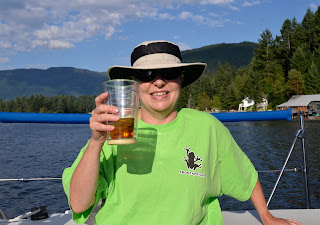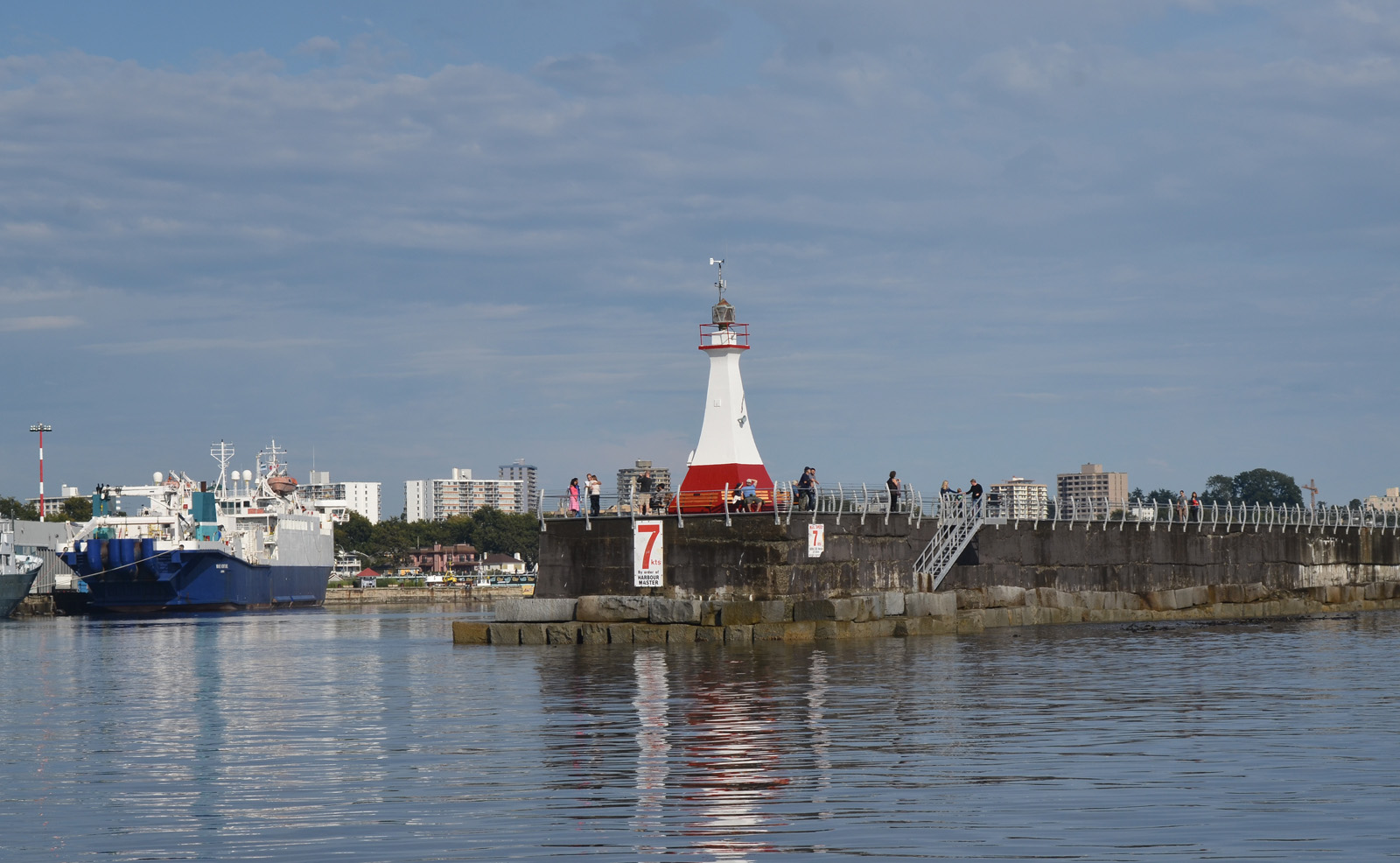Anne
here.
Jim
has been the primary blog writer so far (with a little editing support now and then), but many people have asked “what is it like to live on the boat?” so I thought I
would write a bit to share our daily lifestyle on the water.
 |
| Our "salon" |
Travelling and living on a boat is rather like travelling in an RV – in our case, a very small RV. Thirty-five feet long including bow and stern overhangs, and just over eleven feet wide at maximum beam. Call it two hundred square feet if you include bunk areas. We have a few mod cons that make life a bit more ‘luxurious’ – hot (six gallons when the engine has been running or we are plugged into dock power) and cold running water, a forced-air furnace to warm up the place in the morning or on really rainy cold days, an oven for baking bread and making pizza, and a VERY small freezer in the refrigerator compartment that allows us to have ice cubes for happy hour drinks and keep some meat frozen.
 |
| The "forward stateroom" |
We have a small bathroom (the Head), a small bedroom for 2 (the V-berth in the forward part of the boat) a small kitchen (the Galley), and a small living/dining area (the Salon). We also have a back deck with a propane BBQ (the Cockpit at the Stern or blunt end of the boat) and a front porch (the Bow or pointy end of the boat) as well as a ‘garage’ (the Quarterberth which is the sleeping area for one tucked under one of the cockpit seats).
The front end of the ‘garage’ also doubles as the seat for the desk which is the navigation station or the Nav Table. Just like travelling in an RV, the amount of travel and the weather decides which area of the boat we spend the most time in on any given day. Unlike an RV, we have to stand out in the weather to drive.
 |
| The morning navigatorium + tea |
Storage is a creative adventure and it surprises me on every trip just how much we can store in this wee space we have called home for the last 2 months. There is a treasure trove of necessities and yummy things hidden behind every cushion, in every cupboard and drawer, and under every panel. Even the oven doubles as a place to keep pans for baking as well as the really fragile food such as taco chips.
It depends
on whether we are travelling to a new anchorage or sitting at anchor for a
layover day, whether it is sunny and warm or foggy and/or pouring. Mornings
usually find us drinking copious amounts of tea while listening to the weather
reports on the VHF radio and reading the various cruising guides to discover
all the interesting places to see in the surrounding area. This is generally
our time for catching up on blog writing (usually Jim’s job), entering info
into the boat log (usually Anne’s job), and sorting through pictures from the
previous day. If we are staying for the day and the weather is good, we may put
the small motor on the dinghy and go for an exploratory tour or each of us will
get some exercise paddling - Jim in the dinghy and me in the kayak. The dinghy
is a better platform for Jim to carry his big camera bag and get in for those
close-up pictures of the shoreline. Some days we adventure further going for a
hike to the beaches or up to the waterfalls or hot springs for a swim.
 |
| Some mornings are quite bleak |
Dinner by candlelight is just a lovely way to end a day of travel on the water, especially when you are in a snug anchorage and have lots of fresh ingredients and a good bottle of wine after a successful shopping run.
 |
We could not possibly survive without our egg poaching pan and our BBQ. You can do an unbelievable amount of cooking on the BBQ - we even make toast on the BBQ, since we have no electric toaster onboard. Toast on a boat is a big treat!
We also carry a pancake pan, a cheese grinder, meat thermometer and many other "useless gadgets".
Having a 3 burner propane stove and oven go a long way to keeping the cooking entertaining as do a few cookbooks specially written for the boating life. It's nice to have someone else’s cooking/provisioning experiences to get the creative juices flowing.
And, what about washing up, especially in terms of having a shower? Yes, we do have a shower of sorts in the head, a compartment which has just barely enough standing head room for Jim and just enough room to turn around in if you are careful to keep your elbows close to your sides. There is a handheld showerhead as part of the faucet for the sink so it can be used for really bad hair days - after 4 days of not being able to have a head shower due to travel, inclement weather or because we are watching out for the ever-decreasing level of our fresh water as it all comes from the same 2 small tanks. We are not set up with a water-maker which turns sea water into potable water so after about 6 days of careful water use we start to feel a bit jumpy about how much we may have left.
 |
| Solar showers on deck getting cold |
Provisioning
and laundry as well as loading up on water, and occasionally fuel, are the necessities that
usually make us check into a marina which happens about every 10 days or so.
Provisioning is an adventure in its own right. Making a list to shop in the
tiny marina general stores on the west coast is almost a waste of time as you
just have to take what is there and what is freshest that day. It really makes
you work hard at menu planning which is actually one of the creative aspects of
boating that we both love. Checking the expiry dates on goods in these stores
is a must as sometimes the products have not moved off the shelves for years –
really! In some of the more remote places we just accept that some things are
out of date and are probably OK to eat.
 |
| Great fresh seafood in Ucluelet, definitely OK to eat |
 |
| The fixin's |
 |
| The finished loaf |
 |
| Changing the macerator...notice the fan |
Repairs often call for an all-out attack on the interior, up-ending and uncovering many surfaces and having tools laid out everywhere, in order to get at the job which is usually in the bottom of the boat or in some other inaccessible place which requires lying sideways and upside-down and making your body into a pretzel.
 |
| Checking the batteries |
Jobs such as checking the batteries or changing out the macerator pump, the electric thing which grinds up the stuff in the holding tank (connected to the toilet) as it is pumped out, required a lot of pulling out of everything in one space and then finding a space for it all while the work in in process, not so easy in such a small place to begin with, especially since tools are stashed all over the boat. We are very fortunate that Jim is so handy with all manner of repairs and has a somewhat special aptitude for all things plumbing and electrical!! Being out in the middle of nowhere there is frequently no one else to rely on but ourselves.
 |
| Writing in the log |
I also love to spend time sitting on the ‘front porch’ in my hammock chair, a most wonderful Christmas present from Jim years ago.
There is nothing quite like enjoying happy hour in the sun in a quiet anchorage or having a sunny solar shower in the cockpit – especially if there are no other boats around! And for those rainy days which were blessedly infrequent this summer, there is the tarp cover that we have rigged to go over the cockpit so we can sit out when the weather is really wet. We also have a "storm tarp", good when it's windy, that we use for collecting rain water to support our small supply of potable water onboard.
Living
on a boat is on one hand so much easier than on land and on the other hand so
much trickier. There is nowhere to go if you have a bit of a falling out so
learning to talk it out is a must. There is no one to help you unless you are
close to civilization so you have to know how to manage all the systems and things
that Mother Nature throws at you by yourselves. But there are fewer
things to go wrong and to look after so it all seems to balance out. Living on a boat is all about self-reliance,
creative problem-solving and being able to take it as it comes. It is a most
wonderful way to be one with your surroundings and to have time to get to know
yourself in ways that are not possible in a land-based workday world. It is
always an adventure, a challenge and an experience that is unforgettable.

































